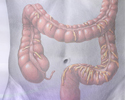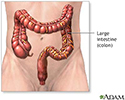Colon cancer screening
Screening for colon cancer; Colonoscopy - screening; Sigmoidoscopy - screening; Virtual colonoscopy - screening; Fecal immunochemical test; Stool DNA test; sDNA test; Colorectal cancer - screening; Rectal cancer - screening
Colon cancer screening can detect polyps and early cancers in the large intestine. This type of screening can find problems that can be treated before cancer develops or spreads. Regular screenings may reduce the risk of death and complications caused by colorectal cancer.
Colon cancer screening
Colon, or colorectal cancer, is cancer that starts in the large intestine (colon) or the rectum (end of the colon). Other types of cancer can affect ...

Polyps
A colorectal polyp is a growth on the lining of the colon or rectum.

Information
SCREENING TESTS
There are several ways to screen for colon cancer.
Stool test:
- Polyps in the colon and small cancers can cause small amounts of bleeding that cannot be seen with the naked eye. But blood can often be found in the stool.
- This method checks your stool for blood.
-
The most common test used is the
fecal occult blood test
(FOBT). Two other tests are called the fecal immunochemical test (FIT) and stool DNA test (sDNA).
Fecal occult blood test
The stool guaiac test looks for hidden (occult) blood in a stool sample. It can find blood even if you cannot see it yourself. It is the most commo...
 ImageRead Article Now Book Mark Article
ImageRead Article Now Book Mark Article
Sigmoidoscopy
Sigmoidoscopy is a procedure used to see inside the sigmoid colon and rectum. The sigmoid colon is the area of the large intestine nearest to the re...

- This test uses a small flexible scope to view the lower part of your colon. Because the test only looks at the last one third of the large intestine (colon), it may miss some cancers that are higher in the large intestine.
- Sigmoidoscopy and a stool test should be used together.
Colonoscopy
A colonoscopy is an exam that views the inside of the colon (large intestine) and rectum, using a tool called a colonoscope. The colonoscope has a sm...

- A colonoscopy is similar to a sigmoidoscopy, but the entire colon can be viewed.
- During a colonoscopy, you receive medicine to make you relaxed and sleepy.
-
Sometimes, CT scans are used as an alternative to a regular colonoscopy. This is called a
virtual colonoscopy
.
Virtual colonoscopy
Virtual colonoscopy (VC) is an imaging or x-ray test that looks for cancer, polyps, or other disease in the large intestine (colon). The medical nam...
Read Article Now Book Mark Article
Other tests:
-
Double-contrast
barium enema
is a special x-ray of the large intestine that looks at the colon and rectum
Barium enema
Barium enema is a special x-ray of the large intestine, which includes the colon and rectum.
 ImageRead Article Now Book Mark Article
ImageRead Article Now Book Mark Article - Capsule endoscopy involves swallowing a small, pill-sized camera that takes a video of the inside of your intestines. The method is being studied, so it is not recommended for standard screening at this time.
SCREENING FOR AVERAGE-RISK PEOPLE
There is not enough evidence to say which screening method is best. But, colonoscopy is most thorough. Talk to your doctor about which test is right for you.
Both men and women should have a colon cancer screening test starting at age 50. Some health care providers recommend that African Americans begin screening at age 45.
Screening options for people with an average risk for colon cancer:
- Colonoscopy every 10 years
- Double-contrast barium enema every 5 years
- FOBT or FIT every year (colonoscopy is needed if results are positive)
- sDNA every 1 or 3 years (colonoscopy is needed if results are positive)
- Flexible sigmoidoscopy every 5 to 10 years, usually with stool testing FOBT done every 1 to 3 years
- Virtual colonoscopy every 5 years
SCREENING FOR HIGHER-RISK PEOPLE
People with certain risk factors for colon cancer may need earlier (before age 50) or more frequent testing.
More common risk factors are:
- A family history of inherited colorectal cancer syndromes, such as familial adenomatous polyposis (FAP) or hereditary nonpolyposis colorectal cancer (HNPCC).
- A strong family history of colorectal cancer or polyps. This usually means close relatives (parent, sibling, or child) who developed these conditions younger than age 60.
- A personal history of colorectal cancer or polyps.
-
A personal history of chronic inflammatory bowel disease (for example
ulcerative colitis
or
Crohn disease
).
Ulcerative colitis
Ulcerative colitis is a condition in which the lining of the large intestine (colon) and rectum become inflamed. It is a form of inflammatory bowel ...
 ImageRead Article Now Book Mark Article
ImageRead Article Now Book Mark ArticleCrohn disease
Crohn disease is a disease where parts of the digestive tract become inflamed. It most often involves the lower end of the small intestine and the be...
 ImageRead Article Now Book Mark Article
ImageRead Article Now Book Mark Article
Screening for these groups is more likely to be done using colonoscopy.
References
Itzkowitz SH, Potack J. Colonic polyps and polyposis syndromes. In: Feldman M, Friedman LS, Brandt LJ, eds. Sleisenger and Fordtran's Gastrointestinal and Liver Disease . 10th ed. Philadelphia, PA: Elsevier Saunders; 2016:chap 126.
US Preventive Services Task Force. Screening for colorectal cancer: US Preventive Task Force Recommendation Statement. JAMA . 2016;315(23):2564-2575. PMID: 27304597 www.ncbi.nlm.nih.gov/pubmed/27304597 .
-
Colon cancer screening
Animation
-
Colonoscopy - illustration
There are 4 basic tests for colon cancer: a stool test (to check for blood), sigmoidoscopy (inspection of the lower colon, colonoscopy (inspection of the entire colon), and double contrast barium enema. All 4 are effective in catching cancers in the early stages, when treatment is most beneficial.
Colonoscopy
illustration
-
Large intestine anatomy - illustration
One of the important jobs of the large intestine is to absorb the remaining water from the food residue passing through the intestines. The residue that is left remains in a semisolid state and is propelled toward the rectum by peristalsis. Through reflexes which are triggered by a full colon, feces is eliminated from the body.
Large intestine anatomy
illustration
-
Sigmoid colon cancer, X-ray - illustration
A barium enema in a patient with cancer of the large bowel (sigmoid area).
Sigmoid colon cancer, X-ray
illustration
-
Fecal occult blood test - illustration
A fecal occult blood test is a noninvasive test that detects the presence of hidden blood in the stool. Blood in the stool that is not visible is often the first, and in many cases the only, warning sign that a person has colorectal disease, including colon cancer.
Fecal occult blood test
illustration
-
Colonoscopy - illustration
There are 4 basic tests for colon cancer: a stool test (to check for blood), sigmoidoscopy (inspection of the lower colon, colonoscopy (inspection of the entire colon), and double contrast barium enema. All 4 are effective in catching cancers in the early stages, when treatment is most beneficial.
Colonoscopy
illustration
-
Large intestine anatomy - illustration
One of the important jobs of the large intestine is to absorb the remaining water from the food residue passing through the intestines. The residue that is left remains in a semisolid state and is propelled toward the rectum by peristalsis. Through reflexes which are triggered by a full colon, feces is eliminated from the body.
Large intestine anatomy
illustration
-
Sigmoid colon cancer, X-ray - illustration
A barium enema in a patient with cancer of the large bowel (sigmoid area).
Sigmoid colon cancer, X-ray
illustration
-
Fecal occult blood test - illustration
A fecal occult blood test is a noninvasive test that detects the presence of hidden blood in the stool. Blood in the stool that is not visible is often the first, and in many cases the only, warning sign that a person has colorectal disease, including colon cancer.
Fecal occult blood test
illustration
-
Colorectal cancer
(Alt. Medicine)
-
Colon and rectal cancers
(In-Depth)
-
Breast cancer
(Alt. Medicine)
-
Non-small cell lung cancer
(In-Depth)
-
Ovarian cancer
(In-Depth)
Review Date: 8/1/2015
Reviewed By: Yi-Bin Chen, MD, Leukemia/Bone Marrow Transplant Program, Massachusetts General Hospital, Boston, MA. Internal review and update on 09/01/2016 by David Zieve, MD, MHA, Isla Ogilvie, PhD, and the A.D.A.M. Editorial team. Editorial update 03/10/2017.







